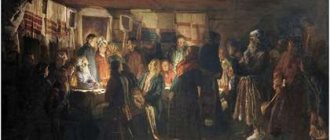An Indian wedding is rightfully considered colorful, because such an abundance of colors cannot be found at any other celebration. The diversity here is noticeable in everything: in the fabrics of clothing, in spices and flowers. An abundance of rituals, soulful songs and dances that can talk about feelings is the basis of an Indian wedding.
Hindus treat marriage with great trepidation, because they believe that not only material ties now connect a man and a woman, but also their souls are united for seven future lives.
An Indian bride must be a virgin, since chastity is an inviolable condition of any marriage. Vedic beliefs have left their mark, so the inhabitants of this country associate a woman with a field. A man is considered as the owner of the field, he must be the first to sow it and harvest the crop, becoming its owner. If the first sower was another person, the man becomes a thief towards the woman, and if they get married, they become outcasts.
From garbhadhana to antiesti kriya
In Indian culture, as in all traditional cultures, significant events in human life - the birth of children, marriage, funerals - are accompanied by various religious ceremonies. The rules for conducting them are described in various scriptures (shastras). And these ceremonies are called in Sanskrit “samskara”, which means “favorable action”. It is believed that samskaras eliminate the bad influence of fate, planets and attract blessings from above.
Vivaha-yajna, or wedding ceremony, is the first and most important in the list of samskaras. It is followed by many other ceremonies such as garbhadhana (conception ritual), pumsavana (rite to produce a healthy child or male child), upanayana (initiation), antyeshti kriya (funeral rituals).
At the end there is always a festive feast and all guests receive gifts.
For each of these ceremonies, astrologers calculate the favorable time (down to the day and hour). The event itself is accompanied by the singing of prayers glorifying God, people put on new clothes, the room is decorated with flowers, filled with aromas, and at the end there is always a festive feast and all guests receive gifts. The shastras report that in earlier times saints (rishis and brahmanas) were necessarily invited to perform rituals, and priests, with the help of various mantras, could even call demigods from the heavenly planets (“Why are there many gods in India and who is the main one”). It is said that in our age, demigods no longer descend to earth and there are no priests left who can summon them. However, the rituals themselves have not lost their auspicious power and are carried out throughout India.
One life - one husband
All world religions impose restrictions on relationships between men and women. Such a relationship is approved only in marriage. However, the sastras go further: even in marriage, they instruct the husband and wife to control their senses. For example, they prohibit sexual relations without the purpose of procreating children. According to this system, marriage is only one stage in a person's life. Family life is a kind of concession for men who are not able to immediately renounce material pleasures and devote their entire lives to serving God. On the other hand, the union of a man and a woman is considered worthy of glory if the husband and wife are determined to do their duty, raise good children and follow religious injunctions. One way or another, by the age of fifty, a man should have developed renunciation, become able to leave home and children and devote himself completely to spiritual practice (“Another View of the Caste System”). And just so that family attachments gradually weaken, there are dharma-shastras (“dharma” is translated as “duty”), which describe in detail the duties of a man and a woman. In short, these instructions boil down to the fact that the wife is obedient and faithful to her husband, and the husband undertakes to take care of his wife spiritually and materially throughout his life.
After the vivaha yajna, the marriage ceremony, the husband and wife are bound together for life. Their connection can only be broken by the death of one of the spouses or the husband’s departure to a monastery. But in both cases the wife should not remarry, she becomes a widow. As women in South India explained to me: one life - one husband. Moreover, the tradition preserves references to such a ritual as sati, when a wife, after the death of her husband, voluntarily entered his funeral pyre, unable to bear separation from him (“Following her husband into the funeral pyre”). For men the situation is slightly different: they can have many wives. However, divorce is not only prohibited by the shastras; such a concept simply does not exist in them. Moreover, people become husband and wife even by simply having sexual relations: although such a marriage is considered low-grade, it also cannot be broken. Until recently, all Indians knew about this (with the exception of that part of the population that came under the influence of the Muslim culture of the conquerors). The languages of India did not even have a word for divorce; it came already in the 20th century from Arabic.
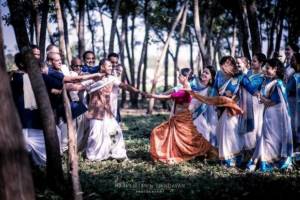
Husband and wife may not even see each other before marriage
Marriage of convenience or sacred duty?
National principles in Indian society were instilled in children from an early age. Therefore, when getting married, the girl did not even imagine that she might not love her husband. Marriage was considered a sacred duty, and chastity was a prerequisite, and a dowry was also required from the girl. But men could still behave more freely, for example, take not one wife into the house, but two or three. Polygamy was not condemned in Indian society, but it was not as common as among the Arabs.

Preparing for marriage
Marriages in India are still most often arranged not by love, but by arrangement. This means that the decision is made by the elders - father, brothers, uncles. Husband and wife may not even see each other before marriage. I know a woman from an educated South Indian family who saw her husband only during the wedding ceremony. They have been together for 30 years. “My husband and I didn’t even see each other before marriage. The parents decided everything between themselves. My sister, all the women in my family got married this way. My mother also did not see my father before marriage. Only after the wedding we could see each other. And then our love began. And there were no problems. What's happening now? They already seem to love each other, talk randomly, then get married, quarrel and get divorced. We have two wonderful children. Sometimes there are some misunderstandings, but we adjust and move on. Someone will say: “Forgive me!” — and everything is fine,” she says.
What also helped me understand this mentality was the non-fiction book A View of Traditional India by Bhakti Vikashi Swami, which contains interviews with representatives of traditional Indian families recalling the culture in which they grew up. One Indian, who lived for a long time in the West, says this about what he saw there: “They put on a whole performance out of love. When the husband drops his wife off at work, they kiss goodbye. (In India, kissing in public, even between husband and wife, is unheard of.) But then they quarrel and get divorced just as easily. In our country, it is not customary to even talk about love, let alone show it to others. It is not necessary. Love manifests itself. A wife cannot help but love her husband. She loves him because he is her husband. Many Americans have asked me about arranged marriage: “How can you marry someone you have never even met? How can you love such a person? To this I replied: “It’s customary for you to fall in love before marriage, and for us - after. The only difference is that after the wedding, your love quickly passes and you get divorced easily. This doesn’t happen here.”
When choosing a bride and groom, their origin, level of income, as well as astrological compatibility are taken into account. Astrologers draw up a chart of the spouses, using which they look at what kind of character they have, how many children they will have, what the life expectancy and future illnesses of the wife and husband are, the possibility of infidelity and much more. An astrologer can determine whether this man and this woman will be happy in marriage, whether they met in a past life, what awaits them in their life together - spiritual development or degradation and suffering. Astrological compatibility still plays a very important role in marriage in religious families today.
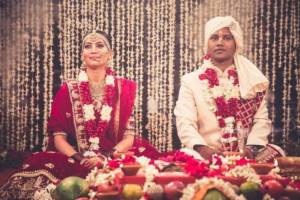
When choosing a bride and groom, their origin, level of income, as well as astrological compatibility are taken into account
Although the rules have become less strict, and relatives take into account the opinion of the bride or groom, and also allow them to meet under adult supervision before the wedding, personal sympathy still does not matter much. Many of my Indian friends couldn't get married for many years because their parents couldn't find someone compatible with them.
Previously, in India, girls were married off very early, at the age of 12-14, upon reaching puberty. The engagement took place even earlier, at a very young age, and all this time the girl knew that she already had a husband. The girls did not go to school; under the supervision of their mother, they learned to cook and run a household. This was the case quite recently. For example, Mahatma Gandhi married his age at the age of 13. In modern India, they are struggling with this tradition due to ridicule from Western society, so they introduced a law that you can only get married from the age of 18. However, this law is often violated, especially in the provinces: according to 2007 data, almost 50% of Indian women get married before the age of 18. The boys also got married early. If these were representatives of the Brahminical class, then after graduating from the gurukula, at the age of 25. And if the lower classes are workers and traders, then much earlier, at 15-16 years old. Before marriage, boys and girls were not allowed to communicate freely. The requirements for female cleanliness were so strict that the girl was forbidden to leave the house without the accompaniment of older relatives, and if she lingered somewhere before dusk, this put an end to her reputation.
Traditions on the eve of the wedding day
The variety of wedding traditions is impressive: each custom has its own meaning and is accompanied by certain actions. The beauty of Indian songs, dances, the rustle of fabrics, an abundance of flowers and incense, delicious national dishes - Indians spare no expense and effort in organizing the celebration.
Meeting with guests
A wedding in India is a special celebration; people spend a long time preparing for it and spending a lot of money. If the family is wealthy, from 15 to 20 thousand dollars are spent on the wedding. 700-800 guests are invited, who need to be provided with housing and food for many days, because the wedding with all the preludes lasts more than a week.
According to a long-standing tradition, four days before the wedding, all her relatives come to the girl’s home and build a wedding canopy in the courtyard, decorated with garlands of flowers, coconuts, bananas, and bright lights. Residents of India call such a canopy a “pandal”. A large bowl of rice is placed in the middle under the canopy, a large coconut palm flower is placed on top of the rice - a symbol of happiness, lights are burning around the bowl.
Mindy's Bachelorette Party
The Mindi ceremony involves decorating the bride's hands and feet with national ornaments using henna. According to the wedding tradition in India, girls’ designs are applied on the palms and above, covering the arms up to the elbow. As a result, something like peculiar gloves emerges. After this, gold rings and bracelets are put on the girl’s hands. The hands and feet were not chosen by chance: the lines of a person’s destiny are drawn on the hands, and all seven chakras are reflected on the hands and feet. What it looks like is shown in the photo.
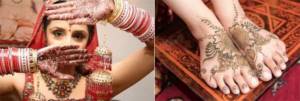
The girl’s relatives and friends try to make the wedding patterns as dark as possible: according to tradition, it is believed that then the future husband will love her more deeply. The procedure lasts almost the whole day: while painting the bride, young girls and experienced women talk to her about what marriage promises, how to behave correctly with her future husband, and how to build a happy family. Therefore, it is believed that the more complex the drawing, the more time it took to complete it, the more secrets of married life the bride learned.
According to the traditions of India, a bride with patterns applied is no longer appropriate to leave the house until the wedding; her home is decorated with bright festive garlands of flowers, light bulbs, and foil. After the wedding, the young wife does not do any housework until the patterns disappear completely.
How to draw Mindy, watch the video:
Sangeet pre-wedding dinner
There is a tradition among the people of India: fifteen days before the wedding begins, Hindus perform a ritual of worshiping Ganesha, the god of wealth and abundance. Representatives of both families ask Ganesha to facilitate the wedding and remove all obstacles to it.
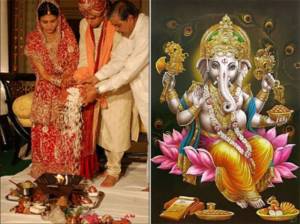
Sanjeet is a purely female pre-wedding ceremony, one of the most joyful and fun in India. Hospitable women from the bride's family invite women from the groom's side to dinner. The whole friendly company wishes the bride family happiness and prosperity with songs, dances, and toasts. The festive table prepared by the bride's relatives is replete with delicious dishes. Dinner lasts a long time, the women have fun from the heart.
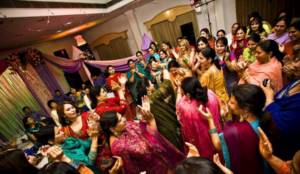
Gaye Kholud ceremony
This is a tradition of praising the color yellow, which in India is considered a symbol of the sun, signifying marital fidelity. It begins at the groom's home: ceremony participants paint their foreheads with yellow paint, and then sprinkle yellow powder on each other. Afterwards, you must inform the deceased relatives that their descendant is getting married. This is done by the groom's father, listing all his ancestors, as if inviting them to witness a significant event.
Having completed the ritual at the young man’s house, the entire procession heads to the girl’s house, where “gaye kholud” is repeated from the beginning.
Dowry
Traditionally, the bride's family prepares a dowry and gives it to the groom so that the newlyweds have everything they need to live until they get back on their feet. These are dishes, jewelry and clothing. It is also important to decorate the bride as beautifully as possible, so the groom’s relatives give her gold jewelry and saris for her wedding. This goes back to the understanding that the bride is a representative of the goddess of prosperity Lakshmi, and if you treat her well, prosperity enters the house with the daughter-in-law.
Of course, not all families can collect a rich dowry for their daughters, so the birth of a girl becomes a heavy burden for many: from the first days, parents begin to save money for her dowry and are ready to go into debt, just not to fall on their face in front of their friends and relatives. There is a good grain in this: traditionally, a wedding is held on a grand scale, so that the irreversibility of the change that has taken place in their lives, surrounded by a large number of witnesses, is imprinted on the minds of the newlyweds. This will force the husband and wife to take their duty in the family more seriously. However, this approach to organizing weddings is often abused, and then preparation for the celebration resembles trading, which causes severe psychological trauma to the bride.
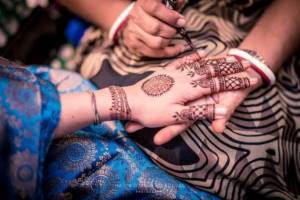
The body of the bride and groom is rubbed with turmeric, and henna designs are applied to the legs and arms
wedding ceremony
The wedding itself, according to Indian canons and traditions, is incredibly beautiful. A fairy tale coming to life before our eyes makes the hearts of even those who have not believed in miracles for a long time tremble. Handsome young people, a white horse, like a girl’s dream come true, and much more. This is how an Indian wedding works.
Arrival of the groom
Every girl's dream is a betrothed on a white horse! According to wedding tradition in India, the groom comes to his chosen one on a white horse decorated with red and yellow garlands. Accompanied by a witness, guests, musicians with loud songs and dances, the groom arrives at the girl’s home. Only men meet him - the bride's father and uncle, all women run out of the way so as not to catch the groom's eye, this is considered a bad omen.
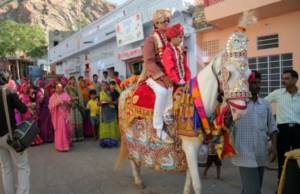
The bride's younger brother is given the honor of meeting the groom at the very gate. According to tradition, he washes his feet and kisses him like a relative.
Shubho drishti - the very first look
The wedding itself in India begins in the evening at the girl’s home. To perform the ceremony, according to tradition, a special tent is built. It is covered with an awning and four palm trees are placed in the corners. The tent is decorated with fresh fragrant flowers, mostly yellow.
The groom, standing on a stone, waits for the wooden palanquin with his betrothed to be taken out. The bearers carry the bride seven times around the groom and stand her down. The guests ask the guy and the girl to look at each other, that is, to perform the wedding ritual of Shubho Drishti - the first glance.
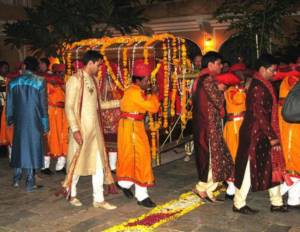
Wedding
According to all traditions, weddings in India are performed on an empty stomach; the newlyweds are forbidden to eat anything until the ceremony is completed.
For weddings, a small wedding temple “vedi” is built from five bamboo sticks, which are covered with an awning on top. A fire is lit inside the temple. One end of the bride's sari is tied to the groom's sash to unite them forever. The newlyweds sit near the fire.
Preliminary rites
Various auspicious rituals precede the wedding ceremony. They take place in the groom's house (where the bride and her relatives are not present) and in the bride's house (where the groom and her relatives cannot be present either). For example, the body of the bride and groom is rubbed with turmeric, and henna designs are applied to the legs and arms. They conduct puja (rite of worship) to the demigods and Vishnu.
The ritual when the groom takes the bride from her father's house especially strikes the imagination of Westerners. The bride dips her palms in turmeric and leaves marks on the walls of her parents' house and the faces of her relatives. At the same time, everyone bursts into sincere tears. Such a farewell can last several hours, and the bride’s crying does not stop all this time. It is difficult for us to understand this today, when cohabitation before marriage is so common. However, in small Indian towns, where many traditions have been preserved, such pictures can still be seen. The fact is that the girl who never left the house alone is very attached to her parents. Moreover, in Indian families following the customs, the daughter is treated with great respect and care, like a goddess (in Sanskrit “kanya”), for example, it is considered unfavorable if the daughter wears someone else’s clothes. With marriage, her carefree life ends. She moves to a new large family, where she will live with other relatives of her husband, mother-in-law, father-in-law, and so on. And in her husband’s house she is no longer a goddess, but a servant: if in her father’s house everyone served her, now she herself must serve and please everyone. Therefore, one can understand the fear that a girl experiences with a change in her life.
Wedding traditions in India
The groom, surrounded by his family, arrives at the bride’s house on a festively decorated elephant, but today a car has begun to take part in the ritual. The girl’s mother, wearing a festive dress, conducts an arati worship ceremony upon meeting, here a red dot - tilak - is applied to the forehead of the future husband. Nearby there is a beautifully decorated wedding tent, under which the main sacred action takes place. Under the shade of a tent, the newlyweds exchange festive garlands of flowers in the Var Mala ritual to the sounds of sacred mantras. This is how they express their consent to marriage.
The joined hands of the young are traditionally tied with symbolic threads. A wedding celebration in India is accompanied by the Kanya Daan ceremony. The father of the future wife washes the hands of the newlyweds with spring water. The clothes of the future spouses are tied at the bottom with a strong knot. The culmination of events is the sacrament of Agni Parinaya, to the sounds of mantras, the newlyweds make three circles around the sacrificial fire, they become spouses only after this.
https://youtube.com/watch?v=n0J6ZGz9o74
After the Sindurdana ceremony, where the groom dyes the parting of his young wife with red dye made from plants, presents her with jewelry, after a sumptuous feast, the blessings of the Brahmin and relatives, the newlyweds go to the husband’s house. As you can see, an Indian wedding is a combination of many rites, rituals and manifestations of Indian culture.
On the threshold of a new house, as part of the ritual of welcoming the bride to her mother-in-law, the girl performs arati according to custom, knocking a jug with rice grains and a small coin onto the floor with her foot, invoking material well-being. Later, the bride is asked to stand with her bare feet in a dish of red dyeing powder and walk into the house, leaving bright marks on the white cloth, symbolizing good luck.
Auspicious date and decorations
"Vivaha-yajna" means "sustaining sacrifice." The man and woman at this ceremony give their future family to God and promise that they will help each other throughout their lives to return to the spiritual world.
First of all, the astrologer selects a favorable date by checking the horoscopes of the bride and groom. Then the attributes for performing the fire sacrifice are prepared: coconut, sandalwood, paraphernalia, ghee, fruits, etc. The ceremony requires a place where the priest and the newlyweds will recite various mantras, throwing grains and fruits into the fire. There are rugs and soft mats (asanas) around the fire for guests to sit on the floor.
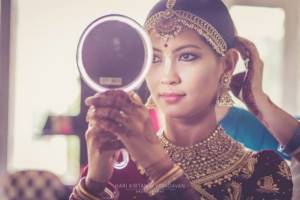
Traditionally, the bride wears 16 pieces of jewelry (shringar)
Great importance is attached to the decoration of the bride and groom. Traditionally, the bride lines her eyes with black kohl, applies auspicious designs and lines (mehendi) to her hands and wears 16 ornaments (shringar): earrings on her ears and nose, hand and anklets, tika (on her forehead), toe rings and others. She also decorates her hair with flowers.
The newlyweds' clothes should be new. The saree worn by the bride is usually red, gold or glittery. The groom wears all white - dhoti, veil, sometimes also kurta (“Why didn’t Indian saris suffer the fate of Tatar kalfaks”).
The room is also decorated, it could be a wedding tent (pandal), an altar room in a temple, the roof of a house or just someone’s apartment. They hang garlands of fresh flowers, mango leaves, which symbolize fertility, place vases with fragrant flowers, pots with banana trees, symbolizing prosperity, lay out coconuts and other green plants, install colored flags, light incense and lamps with ghee. Often weddings are celebrated in decorated wedding tents (pandals).
During the ceremony, a large number of flower petals are used to sprinkle the newlyweds with them; flower garlands are also needed for the newlyweds, the priest, and relatives.
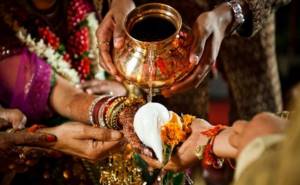
All these hands are sprinkled with sacred water
Top 5 interesting facts related to Indian wedding
A wedding in India is a unique celebration, filled with many interesting moments that can amaze and surprise. Here are some of them:
- The bride does not participate in any way in choosing the groom (as in the case of Muslim weddings). Her parents do this for her. Moreover, they choose mainly according to the horoscope - if the star destinies of the newlyweds coincide, then there will be a wedding.
- A wedding in India is paid for by the bride's side. Moreover, a lot of money is spent on such a celebration. The groom's side only presents expensive gifts to the bride.
- Indian weddings usually amaze with the number of guests - up to 700 people can be invited to the celebration.
- During the period from engagement to wedding, the families of the bride and groom are prohibited from eating meat, only dairy and vegetable dishes. And on the wedding day, before the ceremony begins, the bride and groom have no right to eat anything at all.
- Henna designs on the bride's hands should not be washed off during homework. Therefore, for about a month after the wedding, the young woman rests and enjoys her new status. Great tradition, isn't it?!
Deal
A wedding ceremony is like a theatrical production, where everyone has an assigned role and words. Usually, exquisite verses from the sastras are recited at the wedding, which glorify the good qualities of men and women. This is intended to encourage the newlyweds. The bride's family welcomes the groom, offering him a flower garland and sweet, blessed drinks. The future husband takes a place by the sacred fire. Shells blow and the bride enters with her friends. If the newlyweds have never met before, the bride enters the room covered with a veil held by her friends. The bride sits next to the groom, and when the priest removes the bride's veil, the newlyweds throw flower petals at each other.
The content of vivaha yajna varies slightly in different states and religious schools, of which there are many in India. The key to the ceremony is the “kanya-dana” ritual, when the bride’s father (or simply a married man) joins the hands of the bride and groom: he takes the bride’s right hand and places it on the groom’s right hand, after which he places his hand on top, thereby proclaiming, which gives her away as a wife, while a member of the groom's family places his hand underneath as a sign of welcoming the bride, inviting her to enter her new family. All these hands are sprinkled with sacred water, and the right hands of the bride and groom are tied by the married woman with a garland of flowers. Then the priest asks the groom: “Do you take (the name of the bride) as your wife and do you promise to take care of her in her material and spiritual life and remain faithful to her and not divorce her?” The same question is asked to the bride.
After this, the newlyweds say their vows and can exchange places, flower garlands and wedding rings. The groom promises the bride that he will protect her, take her with him on pilgrimages, share religious and family responsibilities with her, keep her informed about family expenses, not embarrass her in public, not violate the regulative principles or act immorally. The husband also promises to love only her alone, and to treat all other women as his own mother, and to always, to the best of his ability, do everything to make her happy.
The groom also asks the bride to make the following vow: “O beloved! If you promise me that you will not go alone to other people’s gardens or houses, that you will not be alone with other men, if you promise to always be friendly, soft and affectionate, to sacredly keep your marriage vows, to be faithful and devoted to me, your elders and the Almighty Lord and fulfill my family duties, then I will cordially accept you as my lawful wife.”
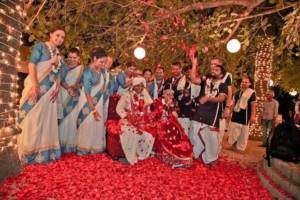
Family members sprinkle rice and flower petals on them, after which they are declared husband and wife
The newlyweds bow to each other, then the groom sprinkles red powder, sindoor, on her parting, which means she is married, and covers her head with a sari (married women traditionally cover their heads outside the home). The end of the groom's robe is tied to the end of the bride's sari; this knot cannot be untied for seven days; it symbolizes the inseparability of their union.
God in the form of fire is invited to witness the marriage, so as a sign of respect, the newlyweds walk around the fire seven times. At this time, family members sprinkle rice and flower petals on them, after which they are declared husband and wife. Then the newlyweds give gifts to all the guests and invite them to a feast.
Indian bride and groom image
Indian brides are extremely beautiful and their outfits are very rich. According to tradition, a wedding sari in India is made of cotton, silk, chiffon in various shades of red or golden. For Hindus, red has long symbolized purity and innocence. Indians consider white to be a mourning color.
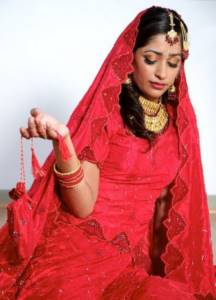
The bride's sari is decorated with elegant embroidery, fringe, rhinestones, and luxurious accessories. The wedding sari is supported by a golden belt. The blouse is sewn either plain, to match the color of the sari, or golden, made of brocade. It is also decorated with embroidery and beads.
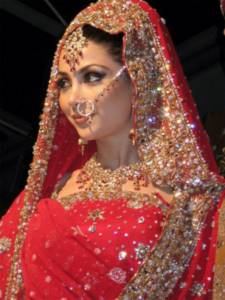
Around the girl’s neck is a gold necklace, passed down from mother to daughter. The bride is also decorated with gold earrings, bracelets on her arms and legs. Bracelets come with ornaments, enamel, and carvings. Jewelry for weddings in India is expensive, and costume jewelry is used very rarely.
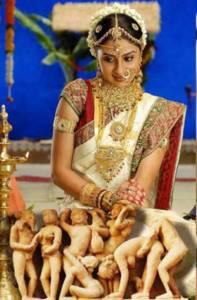
According to all traditions, an Indian bride has one distinctive wedding decoration - a large earring in the wing of her nose, from which a chain extends to her ear, as shown in the photo.
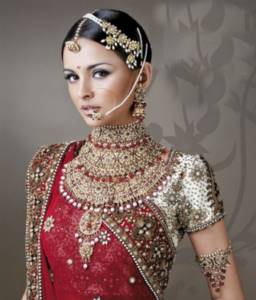
Adhering to an ancient tradition, for the first time at a young girl’s wedding, a bindi is painted with henna - a red dot on the forehead, symbolizing a married woman in India. Bindi comes in different shapes - round, oval and even triangular. Wedding makeup emphasizes the special depth of the girl’s eyes and her eyebrows with clearly defined hairs.
Hair is traditionally styled in a beautiful wedding hairstyle, decorated with flowers and gold jewelry. Punjabi girls and women are extremely modest and shy, their hair is always tied up, among them it is considered the height of indecency to walk with loose hair. In India, only girls of easy virtue or a wife alone with her husband can afford this.
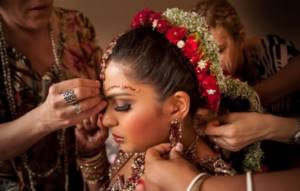
The groom in India also looks very smart. According to tradition, his tight trousers and white and red wedding frock coat are embroidered with gold embroidery. A beautiful red sash girds him. On his feet are shoes with curved toes, embroidered with beads. The head is crowned with a wedding turban made of bright fabric. All this is embroidered with beads, beads, embroidery, glitters and shimmers in the sun. In some parts of India, there has long been a tradition of covering half the face of the groom with pendants made of beads or flowers.
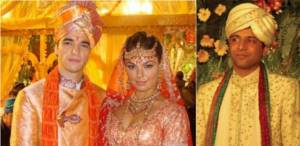
An Indian wedding is not just a holiday or a tradition, it is a merger of two large families, and therefore it is celebrated with special pomp and observance of a huge number of wedding rituals. It is not so easy to study them all. In the video below you can admire the beauty of an Indian wedding:
If you are interested in information about wedding traditions in India, share your impressions and reviews in the comments.
Modern realities
Modern Indians are increasingly abandoning their traditions and adopting Western ideas. Much that was previously considered indecent is now par for the course. For example, the wedding dance of the bride in front of all the guests is becoming fashionable, although in Indian culture a decent woman will never dance in public. Modern weddings are often accompanied by a deafening roar of music speakers and discos. However, there are those who celebrate weddings in accordance with the rules described above. I have attended several such weddings, and I can say that it is a beautiful and memorable ceremony, filled with deep meaning.
Natalia Fedorova, photo from the author’s archive
SocietyCulture
Indian outfits of future spouses

Traditionally, the bride’s attire at a wedding celebration is a burgundy, red or golden Indian wedding dress - a sari, with jewelry and flowers in a braided hairstyle. The eye shape is outlined with a line of black kajal eyeliner, which makes the look mysterious and attractive. A red bindi dot is drawn in the center of the forehead between the eyebrows, a sacred sign of marriage. The parting in the sindur's hair is tinted with red vegetable dye and a mangtika, a special piece of jewelry, is worn.
A nath ring is inserted into the wing of the left nostril, symbolizing marriage. A massive, rather heavy wedding decoration - gold karn phool earrings are inlaid with precious multi-colored stones. Precious necklace for wedding haar has different designs according to local traditions and is inherited in Indian families. Bracelets of different shapes and sizes are worn above the elbow and on the wrist, soldered with bells for the feet.
The groom's formal attire looks no less elegant and beautiful than the bride's dress. He wears an elongated, embroidered sherwani frock coat with narrow matching chiridan pants. Juti shoes are embroidered with beads, usually with their toes raised up. The pagdi turban is also of a special cut; it can be decorated with pendants made of flowers and beads.




